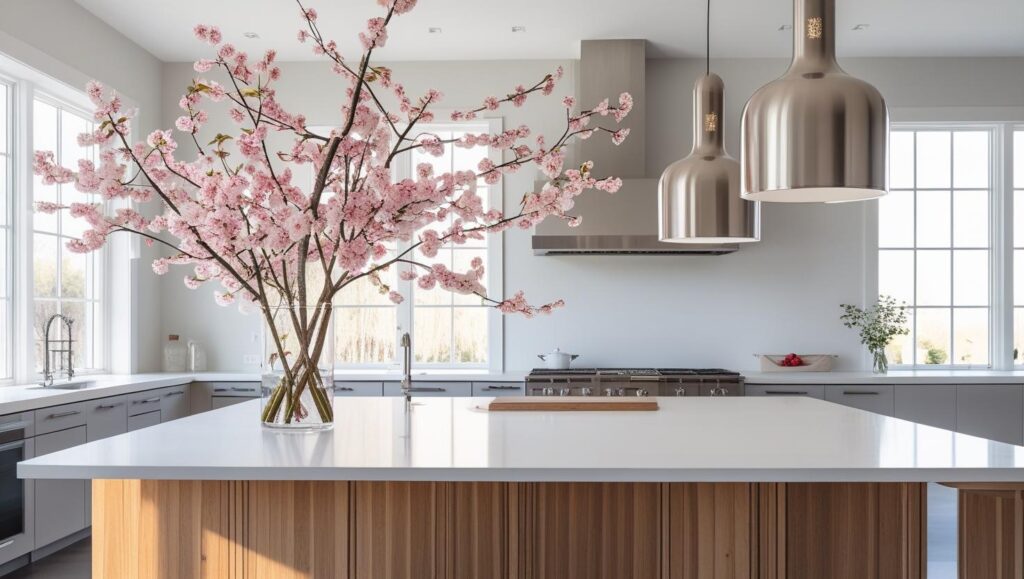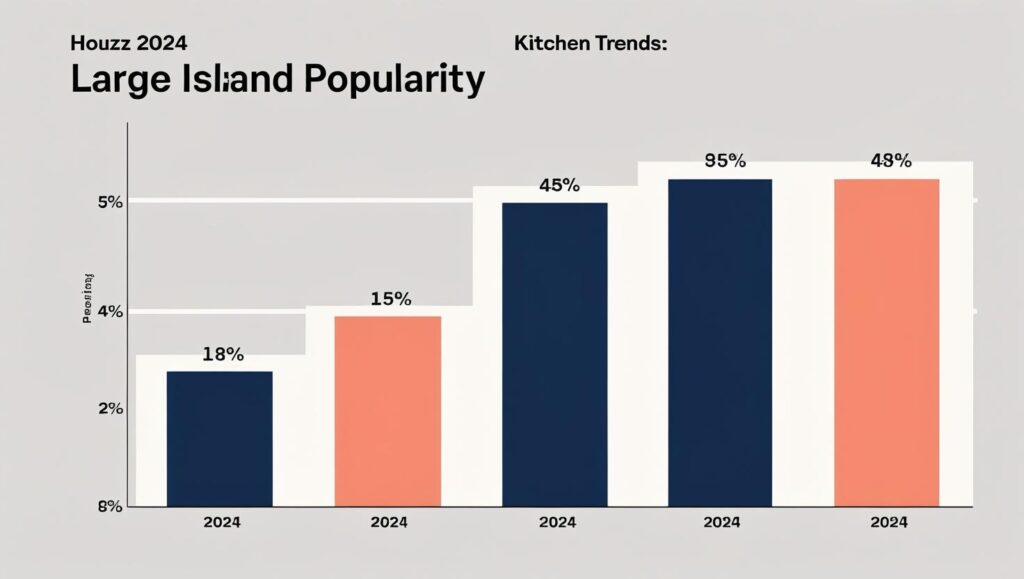
The kitchen island has transcended its utilitarian roots as a mere surface for food preparation. It now stands as the undisputed social and stylistic hub of the modern home. Driven by a trend towards open concept living and a desire for personalized spaces, homeowners are increasingly leveraging sophisticated kitchen island décor ideas to infuse elegance and character into their cooking spaces, according to recent industry analyses.
A landmark 2024 trends study from home renovation platform Houzz reveals a significant resurgence in open-concept kitchens, with 43% of renovating homeowners opting for layouts more open to other indoor areas. This shift places greater emphasis on the island’s aesthetic appeal, transforming it into a central piece of furniture that must harmonize with the broader living environment. Experts observe this is not just about adding clutter, but making deliberate, impactful design choices.
The Shift Towards Personalized, Expressive Design
Industry data indicates a clear departure from the once-ubiquitous all-white kitchen. The National Kitchen & Bath Association (NKBA), in its 2025 Kitchen Trends Report, found that 71% of design professionals now prefer colorful kitchens that showcase a homeowner’s personality. The island is frequently the primary vehicle for this expression.
“It’s clear that unique and personal design is crucial in today’s kitchens,” the NKBA report states, highlighting the island as a prime location for introducing statement colors, contrasting materials, and decorative lighting. This reflects a broader movement where the kitchen is seen as an extension of personal style, much like a living room or bedroom.
Here are 11 expert-backed kitchen island décor ideas that reflect these significant industry trends.
Statement and Sculptural Lighting
Lighting has evolved from a simple necessity to a primary decorative feature. Designers are treating the space above the island as a canvas for sculptural art.
- What experts see: Large-scale pendants, sculptural chandeliers, and fixtures that mix materials like metal and glass are being used to anchor the island and create a dramatic focal point. “Chandeliers over the kitchen island are not exactly a new kitchen lighting trend. But these aren’t your traditional, crystal-dripping pendants. They are sculptural and artistic, almost like a piece of modern art,” notes the design platform Decorilla in its 2025 lighting analysis.
- Application: A single, large linear fixture or a cluster of two to three smaller, artistic pendants can define the space and set a specific mood.
The Power of Natural Materials
Biophilic design—the concept of connecting interiors with nature—is a dominant force. The NKBA reports that 72% of designers say clients want a greater connection to the outdoors.
- What experts see: The use of natural wood, particularly the light, airy grain of white oak, and veined stone like marble and quartzite are increasingly popular for island construction.
- Application: A wooden base, often with reeded or fluted texturing, adds warmth and architectural detail. A “waterfall” countertop, where a stone slab continues vertically down the sides of the island, provides a seamless, high-impact look.

High-Contrast and Two-Tone Palettes
As homeowners move away from monochromatic schemes, the island has become the perfect place for a bold color statement.
- What experts see: The NKBA identifies green as the top color for 2025, followed by blues and rich browns. Designers are specifying islands in a deep, contrasting color to the perimeter cabinets.
- Application: Painting the island base in a saturated shade of forest green or navy blue creates a sophisticated, furniture-like anchor in the room. This technique allows for a pop of color without overwhelming the entire space.
Curated and Functional Surface Décor
In an effort to reduce visual noise, the trend is not to fill the island surface but to style it with a few intentional pieces. The goal is to avoid what designers call “visual clutter.”
- What experts see: A focus on grouping a small number of beautiful yet functional items. “A good rule? One sculptural object (like a ceramic bowl or art piece), one living thing (think potted herbs or a bowl of fruit), and one functional piece (a beautiful cutting board or set of linen napkins),” advises interior designer Rachel Blindauer.
- Application: Use a decorative tray in wood or marble to corral these items. This creates a contained, styled moment that is easily moved when the full counter space is needed.
Biophilic Centerpieces
Directly tying into the nature trend, living elements are a go-to for designers.
- What experts see: A shift from small flower arrangements to more substantial, architectural plant life.
- Application: A large glass vase with tall branches of eucalyptus or olive stems adds height and organic drama. A row of potted herbs in terracotta pots is both aromatic and practical for cooking.
Elevated, Comfortable Seating
As the island becomes a hub for dining, working, and socializing, seating is being upgraded for comfort and style.
- What experts see: A move from backless, utilitarian stools to more substantial seating with backs, upholstery, and considered design details.
- Application: Choose stools that complement the home’s overall design aesthetic, whether it’s woven materials for a coastal feel or upholstered leather for a modern look. This reinforces the idea of the island as a legitimate dining and lounging area.
Mixed-Material Construction
Reflecting a desire for personalized, custom looks, designers are combining different materials in the island’s construction itself.
- What experts see: The NKBA’s 2025 report highlights that 84% of respondents agree that lighting fixtures will increasingly feature differing materials, a trend that extends to the island itself.
- Application: An island might feature a wood base, a stone countertop, and metallic accents in the hardware or as an inlay, creating a rich, layered effect.
Integrated Display Shelving
To break up the visual bulk of a large island, integrated open shelving provides both function and a décor opportunity.
- What experts see: Designers are moving away from the “oversized monolith,” according to Lizzie Spinks, head of design at Makers Furniture, in an interview with Livingetc. Adding open elements makes the island feel lighter.
- Application: Incorporate a small bank of open shelves at one end of the island to display a curated collection of cookbooks, ceramic pitchers, or other beautiful objects.

Textured Vertical Surfaces
Flat, plain cabinet panels are being replaced with more dynamic, tactile surfaces.
- What experts see: Fluting, reeding, and tambour (slatted wood) details are being applied to island bases to add texture and shadow play.
- Application: This architectural detail can be painted a solid color or finished in a natural wood tone. It elevates the island from a simple cabinet block to a piece of custom furniture.
The “Un-Island” Approach
For a less traditional or more eclectic look, some designers are opting for freestanding pieces in place of built-in islands.
- What experts see: The use of antique work tables, console tables, or butcher blocks to serve the function of an island.
- Application: This approach works well in kitchens aiming for a rustic, farmhouse, or “collected” aesthetic. It provides an airy feel and can be a more budget-friendly way to achieve a functional centerpiece.
Purposeful Technology
While not a physical decoration, the integration of subtle technology is a key part of modern island design.
- What experts see: Hidden charging stations, pop-up outlets, and under-counter appliance garages that maintain a clean, uncluttered surface. The Houzz study notes that 91% of projects now feature sustainable elements like LED lighting, often integrated into the island design.
- Application: Plan for integrated outlets with USB ports on the side of the island or under the countertop overhang to support daily life without cluttering the surface with wires.
As lifestyles continue to evolve, the kitchen island’s role as a multi-functional, style-forward centerpiece is set to expand. The focus, according to experts, will remain on creating spaces that are not only beautiful and elegant but also deeply personal and supportive of the myriad activities that now define the heart of the home.
How to Clean Walls Before Painting: The Overlooked Step Experts Say Is Crucial for a Flawless Finish
